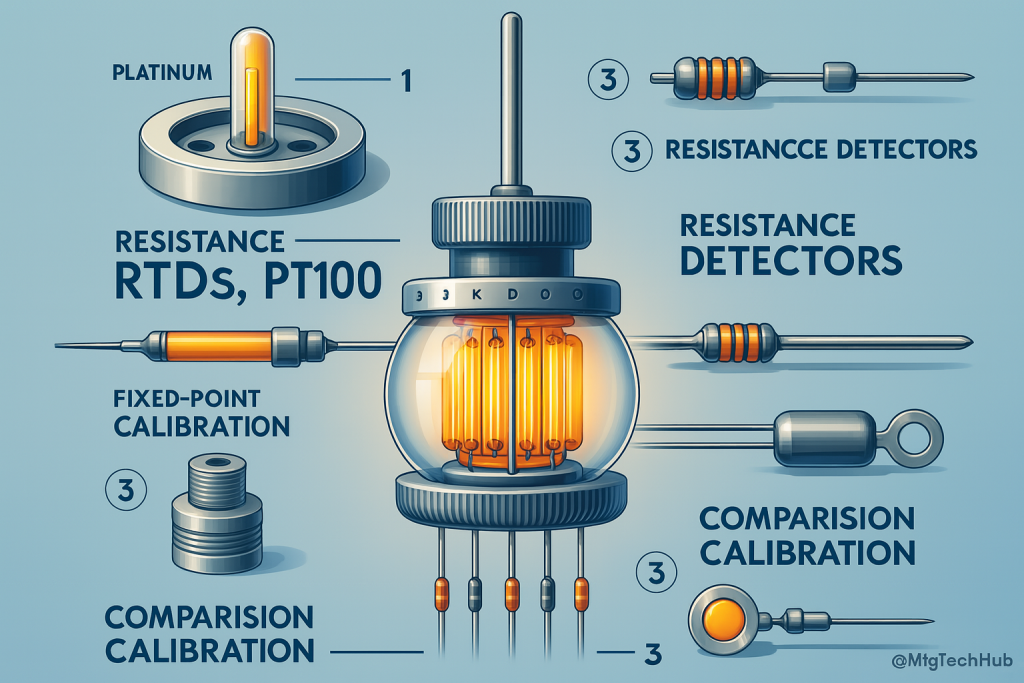Resistance Temperature Detectors (RTDs) and Thermistors
Temperature measurement is a crucial aspect of industrial processes, ensuring safety, efficiency, and quality control. Among the most widely used temperature sensors in industries are Resistance Temperature Detectors (RTDs) and Thermistors. These sensors provide high accuracy, stability, and sensitivity, making them ideal for various applications such as manufacturing, automotive, healthcare, and environmental monitoring.

What is a Resistance Temperature Detector (RTD)?
An RTD is a temperature sensor that operates based on the principle that electrical resistance changes with temperature. RTDs are made of pure metals such as platinum, copper, or nickel, as these materials have a stable and predictable resistance-temperature relationship.
Why Are RTDs Used in Industrial Applications?
- High Accuracy – Provides precise temperature measurements with minimal drift over time.
- Excellent Stability – Offers long-term stability, making it ideal for critical applications.
- Wide Temperature Range – Operates from -200°C to 850°C, depending on the material.
- Good Linearity – Resistance increases consistently with temperature, simplifying calibration.
- Durability – Withstands harsh environments and industrial conditions.
Types of RTDs
RTDs are classified based on the material used and wiring configuration.
1. Platinum RTDs (Pt100, Pt1000)
- Most commonly used type due to high accuracy and stability.
- Pt100 has a resistance of 100 ohms at 0°C, while Pt1000 has 1000 ohms at 0°C.
- Used in industrial automation, chemical plants, and precision manufacturing.
2. Nickel RTDs
- Lower cost than platinum RTDs but has a limited temperature range.
- Used in HVAC systems and refrigeration monitoring.
3. Copper RTDs
- Highly stable but less commonly used in extreme conditions.
- Used in electric motor winding temperature measurement.
4. Wire-Wound vs. Thin-Film RTDs
- Wire-Wound RTDs – Made by winding a platinum wire around a ceramic or glass core. Highly accurate but expensive.
- Thin-Film RTDs – A thin layer of platinum deposited on a ceramic substrate. Less expensive but slightly less accurate.
What is a Thermistor?
A Thermistor is a temperature sensor made of metal oxides that change resistance significantly with temperature. Thermistors are known for their high sensitivity and are used for precise temperature control applications.
Why Are Thermistors Used in Industrial Applications?
- High Sensitivity – Detects even the smallest temperature variations.
- Compact Size – Small and easily integrated into devices.
- Cost-Effective – More affordable than RTDs for low-to-medium temperature applications.
- Fast Response Time – Quickly reacts to temperature changes.
- Ideal for Low-Temperature Applications – Used in medical and environmental monitoring.
Types of Thermistors
1. Negative Temperature Coefficient (NTC) Thermistors
- Resistance decreases as temperature increases.
- Used in temperature sensing, HVAC, and biomedical applications.
2. Positive Temperature Coefficient (PTC) Thermistors
- Resistance increases as temperature increases.
- Common in overheat protection circuits and power electronics.
Comparison of RTDs and Thermistors
| Feature | RTDs | Thermistors |
|---|---|---|
| Accuracy | High accuracy (±0.1°C) | Moderate accuracy (±0.5°C) |
| Temperature Range | -200°C to 850°C | -50°C to 300°C |
| Response Time | Slower (5-30 seconds) | Faster (0.5-10 seconds) |
| Linearity | More linear response | Highly nonlinear |
| Durability | Very stable and long-lasting | Shorter lifespan in extreme conditions |
| Cost | More expensive | Cost-effective |
Common Applications of RTDs and Thermistors
1. Industrial Process Control
- RTDs are used in chemical plants, power plants, and manufacturing to monitor high-temperature processes.
- Thermistors are used in HVAC systems and refrigeration units for environmental control.
2. Automotive Industry
- RTDs monitor engine and exhaust temperatures for efficiency.
- Thermistors are used in battery management systems for electric vehicles.
3. Medical & Healthcare Equipment
- RTDs are used in medical sterilization devices and laboratory incubators.
- Thermistors monitor body temperature in digital thermometers.
4. Electronics and Power Systems
- RTDs measure temperature in semiconductor manufacturing.
- PTC thermistors protect power circuits from overheating.
RTD and Thermistor Calibration
Calibration ensures accurate temperature readings over time. Sensors can drift due to environmental exposure, requiring regular calibration based on industry standards.
Methods of Calibration
1. Fixed-Point Calibration
- Uses known reference temperatures like ice point (0°C) or boiling water (100°C).
- Provides high accuracy for laboratory calibration.
2. Comparison Calibration
- Compares the sensor output with a high-precision reference thermometer.
- Used in industrial calibration labs.
3. Dry-Block Calibration
- Involves placing the sensor in a calibrated heating block set to a fixed temperature.
- Ideal for on-site calibration in industries.
Best Practices for RTD and Thermistor Installation & Maintenance
- Use Proper Wiring – RTDs require 3-wire or 4-wire configurations for precise readings.
- Prevent Electrical Noise – Shield cables to avoid interference in industrial environments.
- Regular Calibration – Establish periodic calibration schedules for accuracy.
- Choose Correct Sensor Type – Use RTDs for high-precision, high-temperature applications and thermistors for fast response needs.
- Protect Against Mechanical Stress – Install sensors in thermowells for harsh conditions.
Future Trends in Temperature Sensors
- Wireless RTDs and Thermistors – Real-time monitoring with IoT and cloud-based analytics.
- AI-Based Predictive Maintenance – Self-diagnosing sensors to detect performance issues before failures occur.
- Nano-Material Thermistors – New materials with higher sensitivity and durability.
- Integrated Smart Temperature Control – AI-driven temperature monitoring for Industry 4.0 applications.
RTDs and thermistors are essential temperature measurement sensors in industrial applications. RTDs provide high accuracy and stability, making them ideal for high-temperature environments, while thermistors offer cost-effective, fast-response solutions for low-to-medium temperature ranges. As technology advances, smart sensors and AI-driven monitoring will further enhance industrial temperature control systems.
